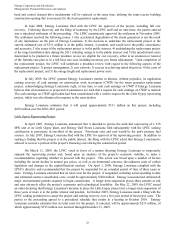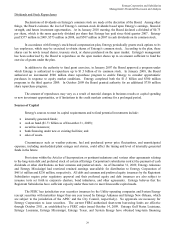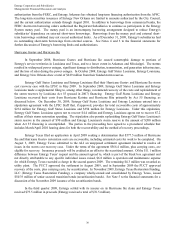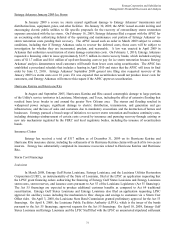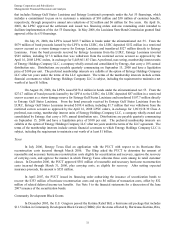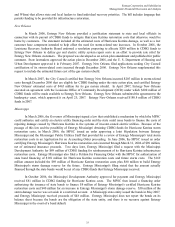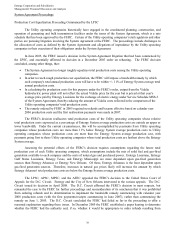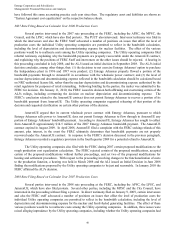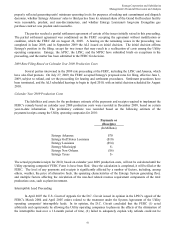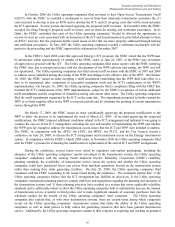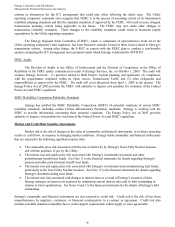Entergy 2009 Annual Report Download - page 40
Download and view the complete annual report
Please find page 40 of the 2009 Entergy annual report below. You can navigate through the pages in the report by either clicking on the pages listed below, or by using the keyword search tool below to find specific information within the annual report.
Entergy Corporation and Subsidiaries
Management's Financial Discussion and Analysis
36
System Agreement Proceedings
Production Cost Equalization Proceeding Commenced by the LPSC
The Utility operating companies historically have engaged in the coordinated planning, construction, and
operation of generating and bulk transmission facilities under the terms of the System Agreement, which is a rate
schedule that has been approved by the FERC. Certain of the Utility operating companies' retail regulators and other
parties are pursuing litigation involving the System Agreement at the FERC. The proceedings include challenges to
the allocation of costs as defined by the System Agreement and allegations of imprudence by the Utility operating
companies in their execution of their obligations under the System Agreement.
In June 2005, the FERC issued a decision in the System Agreement litigation that had been commenced by
the LPSC, and essentially affirmed its decision in a December 2005 order on rehearing. The FERC decision
concluded, among other things, that:
The System Agreement no longer roughly equalizes total production costs among the Utility operating
companies.
In order to reach rough production cost equalization, the FERC will impose a bandwidth remedy by which
each company's total annual production costs will have to be within +/- 11% of Entergy System average total
annual production costs.
In calculating the production costs for this purpose under the FERC's order, output from the Vidalia
hydroelectric power plant will not reflect the actual Vidalia price for the year but is priced at that year's
average price paid by Entergy Louisiana for the exchange of electric energy under Service Schedule MSS-3
of the System Agreement, thereby reducing the amount of Vidalia costs reflected in the comparison of the
Utility operating companies' total production costs.
The remedy ordered by FERC in 2005 required no refunds and became effective based on calendar year
2006 production costs and the first reallocation payments were made in 2007.
The FERC's decision reallocates total production costs of the Utility operating companies whose relative
total production costs expressed as a percentage of Entergy System average production costs are outside an upper or
lower bandwidth. Under the current circumstances, this will be accomplished by payments from Utility operating
companies whose production costs are more than 11% below Entergy System average production costs to Utility
operating companies whose production costs are more than the Entergy System average production cost, with
payments going first to those Utility operating companies whose total production costs are farthest above the Entergy
System average.
Assessing the potential effects of the FERC's decision requires assumptions regarding the future total
production cost of each Utility operating company, which assumptions include the mix of solid fuel and gas-fired
generation available to each company and the costs of natural gas and purchased power. Entergy Louisiana, Entergy
Gulf States Louisiana, Entergy Texas, and Entergy Mississippi are more dependent upon gas-fired generation
sources than Entergy Arkansas or Entergy New Orleans. Of these, Entergy Arkansas is the least dependent upon
gas-fired generation sources. Therefore, increases in natural gas prices likely will increase the amount by which
Entergy Arkansas' total production costs are below the Entergy System average production costs.
The LPSC, APSC, MPSC, and the AEEC appealed the FERC's decision to the United States Court of
Appeals for the D.C. Circuit. Entergy and the City of New Orleans intervened in the various appeals. The D.C.
Circuit issued its decision in April 2008. The D.C. Circuit affirmed the FERC's decision in most respects, but
remanded the case to the FERC for further proceedings and reconsideration of its conclusion that it was prohibited
from ordering refunds and its determination to implement the bandwidth remedy commencing with calendar year
2006 production costs (with the first payments/receipts commencing in June 2007), rather than commencing the
remedy on June 1, 2005. The D.C. Circuit concluded the FERC had failed so far in the proceeding to offer a
reasoned explanation regarding these issues. In December 2009 the FERC established a paper hearing to determine
whether the FERC had the authority and, if so, whether it would be appropriate to order refunds resulting from
38


